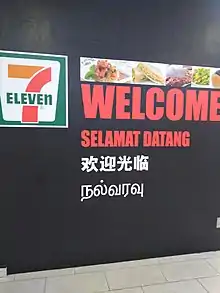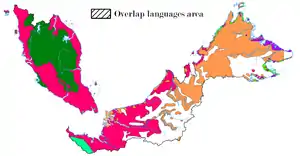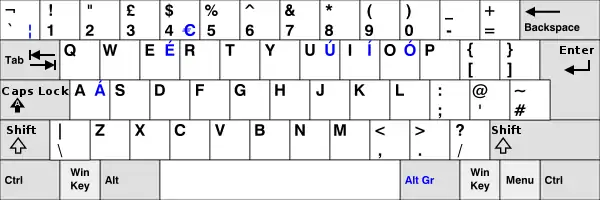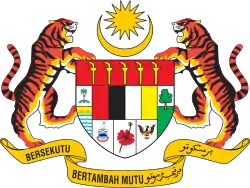Languages of Malaysia
The indigenous languages of Malaysia belong to the Mon-Khmer and Malayo-Polynesian families. The national, or official, language is Malay which is the mother tongue of the majority Malay ethnic group. The main ethnic groups within Malaysia are the Malays, Chinese and Indians, with many other ethnic groups represented in smaller numbers, each with its own languages. The largest native languages spoken in East Malaysia are the Iban, Dusunic, and Kadazan languages. English is widely understood and spoken in service industries and is a compulsory subject in primary and secondary school. It is also the main language spoken in most private colleges and universities. English may take precedence over Malay in certain official contexts as provided for by the National Language Act, especially in the states of Sabah and Sarawak, where it may be the official working language.
Malaysia contains speakers of 137 living languages,[1] 41 of which are found in Peninsular Malaysia.[2] The government provides schooling at the primary level in each of the three major languages, Malay, Mandarin and Tamil. Within Malay and Tamil there are a number of dialectal differences.[3] There are a number of Chinese languages native to the ethnic Chinese who originated from southern China, which include Yue, Min and Hakka Chinese.
Malay
The official language of Malaysia is the Malaysian standardised form of the Malay language (Malay: Bahasa Malaysia).[4] There are 10 dialects of Malay used throughout Malaysia.[3] Malay became predominant after the 13 May Incident.[5] A variant of the Malay language that is spoken in Brunei is also commonly spoken in East Malaysia. Standard Malay is often a second language following use of a local Malay dialect. The standard language is promoted as a unifying symbol for the nation across all ethnicities, linked to the concept of Bangsa Malaysia (Malaysian race). The status as a national language is codified in Article 152 of the constitution.[6] The passage of the National Language Act 1963/67 also strengthened the position of the language. The Education Act of 1996 reiterates that Malay is to be "the main medium of instruction in all educational institutions in the National Education System", with certain exceptions.
Other indigenous languages
Citizens of Minangkabau, Bugis or Javanese origins, who can be classified "Malay" under constitutional definitions may also speak their respective ancestral tongues. The native tribes of East Malaysia have their own languages which are related to, but easily distinguishable from, Malay. Iban is the main tribal language in Sarawak while Dusun and Kadazan languages are spoken by the natives in Sabah.[7] Some of these languages remain strong, being used in education and daily life.[3] Sabah has tenth sub-ethnic languages, Bajau, Bruneian, Murut, Lundayeh/Lun Bawang, Rungus, Bisaya, Iranun, Sama, Suluk and Sungai. There are over 30 native groupings, each of which has its own dialect. These languages are in danger of dying out, unlike the major ones such as Kadazandusuns which have developed educational syllabuses. Iban also has developed an educational syllabus.[8] Languages on the peninsula can be divided into three major groups, Negrito, Senoi, and Malayic, further divided into 18 subgroups.[3] The Semai is used in education.[8] Thai is also spoken in northern parts of the peninsula, especially in Northern Kedah and Langkawi, Perlis, Northern Perak, Northern Terengganu, and Northern Kelantan.[9]
English
Malaysian English, also known as Malaysian Standard English (MySE), is a form of English derived from British English, although there is little official use of the term except with relation to education. English was used in the Parliament briefly upon independence (then as Federation of Malaya), prior to a gradual and complete transition to the Malay language, and continued to be used today for specific terminologies with permission. English, however, remains an official language in the State Legislative Assemblies and Courts of Sabah and Sarawak.[10][11][12] Malaysian English differs little from standard British English.[6]
Malaysian English also sees wide usage in business, along with Manglish, which is a colloquial form of English with heavy Malay, Chinese, and Tamil influences. Most Malaysians are conversant in English, although some are only fluent in the Manglish form. The Malaysian government officially discourages the use of Manglish.[13] Many businesses in Malaysia conduct their transactions in English, and it is sometimes used in official correspondence.
The federal constitution provides that English would continue to serve as an official language for at least 10 years after Merdeka until the parliament provides otherwise.[14] The passage of the National Language Act re-iterated the primacy of Malay as an official language for most official purposes, however the act provides for the use of English in certain official contexts. Among these, section 5 provides that English may be used in the parliament and state assemblies with the presiding officer's permission. Article 152(3) of the constitution and sections 6-7 of the National Language Act provide that all federal and state laws must be enacted in Malay and English.
The Malaysia Agreement,[15] provided for the continued use of English in Sabah and Sarawak for any official purpose.[16] Under article 161(3) of the constitution, federal legislation affecting the use of English in Sabah and Sarawak would not become law in these states unless approved by their respective legislative assemblies. Sarawak has not adopted the National Language Act; meanwhile Sabah has amended its constitution to provide for Malay as "the official language of the state cabinet and assembly".[17]
English was the predominant language in government until 1969.[5] There is significant tension regarding the status and usage of English in the country, as the language is seen both as a historical colonial imposition and as a crucial skill for academic achievement and global business.[6] English served as the medium of instruction for Maths and Sciences in all public schools per the PPSMI policy, but reverted to Bahasa Malaysia in national schools and mother-tongue languages in 2012.[18] The Parent Action Group for Education and former Prime Minister Tun Dr Mahathir Mohamad has called for science and maths to be taught in English again.[3][19][20]
Chinese language and regiolects
As a whole, Standard Chinese (Mandarin) and its Malaysian dialect are the most widely spoken forms among Malaysian Chinese, as it is a lingua franca for Chinese who speak mutually unintelligible varieties; Mandarin is also the language of instruction in Chinese schools and an important language in business.[3]
As most Malaysian Chinese have ancestry from the southern provinces of China, various southern Chinese varieties are spoken in Malaysia (in addition to Standard Chinese (Mandarin) which originated from northern China and was introduced through the educational system). The more common forms in Peninsular Malaysia are Hokkien, Cantonese, Hakka, Hainanese, and Hokchew.[9] Hokkien is mostly spoken in Penang, Northern Perak and Kedah whereas Cantonese is mostly spoken in Ipoh and Kuala Lumpur. In Sarawak, most ethnic Chinese speak Hokkien, Hokchew, or Hakka. Hakka predominates in Sabah except in the city of Sandakan where Cantonese is more frequently spoken despite the Hakka origins of the Chinese residing there.
As with Malaysian youths of other ethnicities, most Chinese youth are multilingual and can speak at least three languages with at least moderate fluency - Mandarin, English, and Malay, as well as their Chinese regiolect and/or the dominant Chinese regiolect in their area. However, most Chinese regiolects are losing ground to Mandarin, due to its prestige and use as the language of instruction in Chinese vernacular schools. Some parents speak exclusively in Mandarin with their children. Some of the less-spoken regiolects, such as Hainanese, are facing extinction.
Tamil
Tamil and its Malaysian dialect are used predominantly by Tamils, who form a majority of Malaysian Indians.[21] It is especially used in Peninsular Malaysia. The Education Act of 1996 regulates the use of Tamil as medium of instruction at the primary level in "national-type schools", and also entitles Tamil children to obtain Tamil classes in national primary schools and national secondary schools (which use Malay as medium of instruction), provided "it is reasonable and practicable so to do and if the parents of at least fifteen pupils in the school so request".[22][23]
Tamil-speaking immigrants to Malaysia came from two groups, Sri Lankan Tamils who spoke Sri Lankan Tamil dialects such as the Jaffna Tamil dialect, and Indian Tamils who spoke dialect from Tamil Nadu. These dialects reflected class differences, with the Sri Lankan Tamils being more educated and overseeing the Indian Tamils, who primarily served as labourers on rubber estates. These two communities with their very different dialects remained mostly separate in Malaysia, forming two separate Tamil communities. Tamil is becoming less common among the more highly educated Tamil population, being predominantly replaced by English, and in a minority by Malay. Tamil-medium schools are considered less advantageous than English-medium schools, bringing little prospect of socioeconomic advancement. While the Malaysian government provides limited support for elementary Tamil schooling, secondary school is only taught in Malay, and there are no Tamil private schools. Usage of Tamil remains common among the less educated Tamil community, who often continue to live in their own communities on or near plantations, or in urban squatter settlements.[24]
One small group of former Tamil speakers, the Chitty, almost entirely speak Malay.[24]
Other Indian languages
The Malayalees in Malaysia are known to be the second largest Indian ethnicity, after the Tamils.[25] Malayalees can be found in the West Coast states, mostly in Penang, Perak (Sitiawan & Padang Rengas), Selangor and Negeri Sembilan (Labu & Bahau). They can be classified into 3 major groups; labourers, traders, government servants and estate clerks. Malayalee labourers were predominantly Hindus from Palakkad and Cannannore regions in Malabar. These communities spoke South Malabar dialect and Kannur dialect. Some of the labourers who were not associated with the Kangani system were placed in estates that had mix ethnicities, mostly Tamils. Thus, these labourers mix around with the Tamils and eventually used Tamil vocabularies in their language. Some have even received formal Tamil education, which eventually lead them to not speaking Malayalam as their first language but Tamil. The Malayalam-speaking traders who came to Malaya were mostly from the Muslim communities in Malabar. They spoke the Moplah dialect, which has influence of Arabic and Persian language. This particular dialect is still used among today's Malabari Muslims. Besides, Malayalees who were employed as estate clerks and semi-professional positions in the Malayan Civil Service consists of Hindus and Christians from Cochin and Travancore, as they were educated. These people spoke Malayalam dialects which are similar to the standard Malayalam spoken today. Majority of the youngsters of the Malayalee community are unable to speak their mother tongue fluently because of the usage of English among the highly educated Malayalees and the domination of Tamil, as a lingua franca of the Malaysian Indians.[26]
Other South Asian languages such as Bengali, Hindi, Punjabi, Sinhala and Telugu are also spoken.
Creoles
A small number of Malaysians have Eurasian ancestry and speak creole languages, such as the Portuguese-based Malaccan Creoles.[27] A Spanish-based creole, Zamboangueño, a dialect of Chavacano, has spread into Sabah from the southern Philippines.[28]
Sign languages
Sign languages include Malaysian Sign Language and the older Selangor Sign Language and Penang Sign Language. No sign language is used in the education of the deaf. Instead, Manually Coded Malay is used.
List of languages

Native languages in Peninsular Malaysia
Native languages in Malaysian Borneo
Other languages recognised as Native
Estimated number of speakers in Malaysia as of 2019:[29]
| Language | Code | Speakers | Family |
|---|---|---|---|
| Acehnese | ace | 84,000 | Chamic (Austronesian) |
| Banjarese | bjn | 26,000 | Malayic (Austronesian) |
| Buginese | bug | 143,000 | South Sulawesi (Austronesian) |
| Cham | cja | 13,000 | Chamic (Austronesian) |
| Javanese | jav | 661,000 | Javanese (Austronesian) |
| Kerinci | kvr | Malayic (Austronesian) | |
| Mandailing | btm | 31,000 | Northwest Sumatra–Barrier Islands (Austronesian) |
| Minangkabau | min | 931,000 | Malayic (Austronesian) |
Malaysian Chinese languages
Estimated number of speakers in Malaysia as of 2019:[29]
| Language | Code | Speakers | Family |
|---|---|---|---|
| Cantonese | yue | 1,443,000 | Sino-Tibetan |
| Foochow | fzho | 260,000 | Sino-Tibetan |
| Hakka | hak | 1,787,000 | Sino-Tibetan |
| Hainanese | nan | 405,000 | Sino-Tibetan |
| Hokkien | nan | 1,966,000 | Sino-Tibetan |
| Mandarin | cmn | 1,019,000 | Sino-Tibetan |
| Min Bei | mnp | 397,000 | Sino-Tibetan |
| Teochew | nan | 1,038,000 | Sino-Tibetan |
Malaysian Indian languages
Estimated number of speakers in Malaysia as of 2019:[29]
| Language | Code | Speakers | Family |
|---|---|---|---|
| Gujarati | guj | 29,000 | Indo-European |
| Hindi | hin | 59,000 | Indo-European |
| Bengali | Ben | 81,000 | Indo-European |
| Malayalam | mal | 344,000 | Dravidian |
| Punjabi | pan | 69,000 | Indo-European |
| Tamil | tam | 1,856,000 | Dravidian |
| Telugu | tel | 117,000 | Dravidian |
| Urdu | urd | 15,000 | Indo-European |
See also
References
- "Ethnologue report for Malaysia". Ethnologue.com. Retrieved 18 October 2010.
- "Ethnologue report for Malaysia (Peninsular)". Ethnologue.com. Archived from the original on 10 May 2011. Retrieved 18 October 2010.
- Kamila Ghazali. "National Identity and Minority Languages". UN Chronicle. Archived from the original on November 2, 2012. Retrieved 4 September 2013.
- Constitution of Malaysia:Article 152
- Barbara Watson Andaya; Leonard Y. Andaya (15 September 1984). A History of Malaysia. Palgrave Macmillan. ISBN 978-0-312-38121-9.
- Kärchner-Ober, Renate (2013). "Linguistic quandary in multilingual Malaysia: Socio-political issues, language policy, educational changes". In Singleton, D M; Fishman, Joshua A; Aronin, Larissa; Ó Laoire, Muiris (eds.). Current Multilingualism : a New Linguistic Dispensation. Berlin: De Gruyter Mouton. pp. 299–310. ISBN 9781614513896.
- K. Alexander Adelaar; Nikolaus Himmelmann (1 January 2005). The Austronesian Languages of Asia and Madagascar. Psychology Press. pp. 397–. ISBN 978-0-7007-1286-1.
- Luke Rintod (30 November 2010). "Speak up, native language champions urged". Free Malaysia Today. Retrieved 4 September 2013.
- "Malaysia". Cia.gov. Retrieved 26 October 2010.
- "My Constitution: Sabah, Sarawak and special interests". The Malaysian Bar. The Malaysian Bar. 2 February 2011. Retrieved 14 August 2019.
English has been the official language of the State Legislative Assemblies and Courts in Sabah and Sarawak since Malaysia Day, Sept 16, 1963. Any change of the official language to Bahasa Melayu can only become effective when the State Legislative Assembly of Sabah or Sarawak agrees to adopt federal laws that make Bahasa Melayu the official language.
- "Article 32 of the National Language Act has no legal effect in Sarawak". Dayak Daily. Subang Jaya, Selangor. 5 September 2018. Retrieved 14 August 2019.
- "S'wak govt never agreed to change present policy on English usage". Borneo Post. Kuching, Sarawak. 5 September 2018. Retrieved 14 August 2019.
- Zimmer, Benjamin (5 October 2006). "Language Log: Malaysia cracks down on "salad language"". Itre.cis.upenn.edu. Retrieved 14 September 2010.
- Constitution, article 152(2)
- which provided for North Borneo, Sarawak, and Singapore joining the Federation of Malaya
- Malaysia Agreement, section 61(2)
- Sabah Constitution, article 11a
- "Math and Science back to Bahasa, mother tongues". The Star Online. 8 July 2009. Retrieved 8 September 2010.
- Mohd Farhan Darwis (12 November 2013). "Dr Mahathir calls for Science and Maths to be taught in English, again". The Malaysian Insider. Archived from the original on 2014-10-18. Retrieved 3 October 2014.
- "PAGE hands in second memorandum". The Star Online. 9 July 2010. Archived from the original on 2014-10-18. Retrieved 8 September 2010.
Deputy Prime Minister Tan Sri Muhyiddin Yassin announced last year that the policy of Teaching of Mathematics and Science in English (known by its Malay acronym, PPSMI) would be scrapped from 2012.
- Barbara A. West (1 January 2009). Encyclopedia of the Peoples of Asia and Oceania. Infobase Publishing. ISBN 978-1-4381-1913-7.
- "Act 550 – Education Act 1996" (PDF). Retrieved 28 Jan 2021.
- Ghazali, Kamila (2010). UN Chronicle – National Identity and Minority Languages. United Nations, accessed 28 Jan 2021.
- Schiffman, Harold F. (1995). "Language Shift in the Tamil Communities of Malaysia and Singapore: the Paradox of Egalitarian Language Policy". Language Loss and Public Policy. 14 (1–2). Retrieved 9 August 2020.
- https://joshuaproject.net/people_groups/17433/MY
- Sercombe, P.; Tupas, R. (2014). Language, Education and Nation-building: Assimilation and Shift in Southeast Asia. Springer. p. 139. ISBN 9781137455536.
- "Malaysian Creole Portuguese: Asian, African or European?". 17. University of Texas. 1975: 211–236. JSTOR 30027570. Cite journal requires
|journal=(help) - Susanne Michaelis (2008). Roots of Creole Structures: Weighing the Contribution of Substrates and Superstrates. John Benjamins Publishing. ISBN 90-272-5255-6.
- "Country: Malaysia". Joshua Project.
External links
- Languages of Malaysia at Muturzikin.com
- borneodictionary.com - Dictionary of Borneo Languages
- Omar, Asmah Haji (2015-12-16). Languages in the Malaysian Education System: Monolingual strands in multilingual settings. Routledge. ISBN 978-1-317-36421-4.


